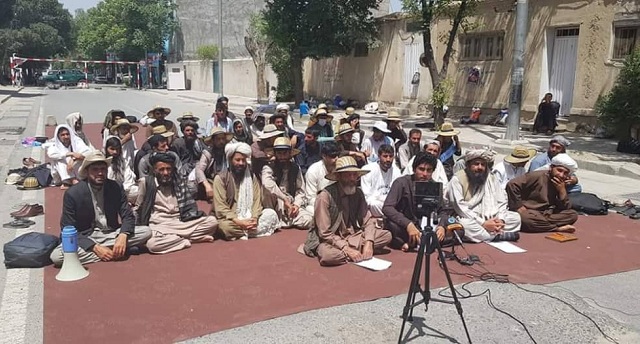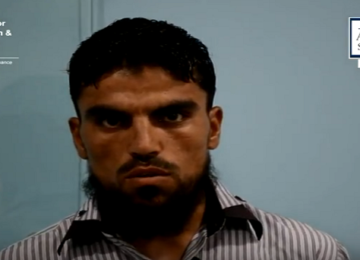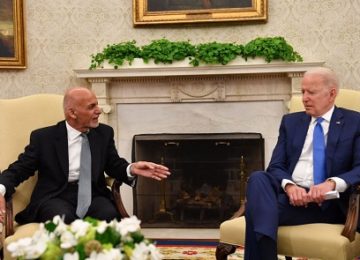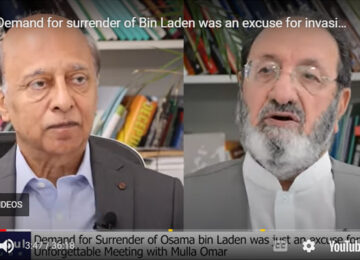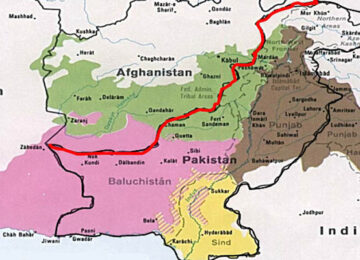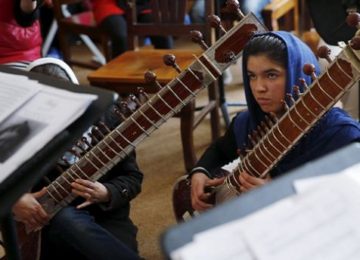Although the Eid ceasefires have been and gone, they have rekindled hopes across Afghanistan that peace is possible. Helmand’s peace movement is keeping up the pressure. It has staged sit-ins in front of embassies in Kabul and sent letters to countries participating in or supporting the war effort. The movement has also reached other parts of the country. Its members claim that the Taleban have softened their approach towards them. AAN’s Ali Mohammad Sabawoon and Thomas Ruttig (with input from Emilie Cavendish) have been looking at the peace marchers’ latest activities, as well as their strategy.
Following the Eid ceasefires, the Helmand Peace Movement that formed after a suicide attack in Lashkargah in March (with a subsequent high-profile 770-kilometre march lasting 37 days to the capital, Kabul, where it arrived as Eid celebrations were underway), is keeping up the pressure on all sides involved in the Afghan war in its attempts to bring the conflict to an end. Iqbal Khaibar, the head of the People’s Peace Movement (in Pashto, De Sole Wulusi Harakat) told AAN on 20 July, “The Eid ceasefire influenced our efforts well. People contact us every day. They motivate us and tell us that they are with us. […] We got a public image now.”
There are “120 individuals from Helmand, Uruzgan, Kandahar, Zabul, Ghazni, Wardak, Bamyan, Nangrahar, Herat, Baghlan, Paktia, Paktika and Kabul” now participating in the movement in Kabul, Khaibar told AAN:
As we do not have [enough] money for food, we send half of them home, and then those who have gone home come back and then the rest of the protestors [takes a rest]. The Kabul money exchanger union and the Jaji [tribal] shura are giving us food. Sometimes women come here and they offer us food. Our only problem is money, and the colleagues are all poor people.
Bismillah Watandost, the People’s Peace Movement spokesman, told AAN on 8 July one of the latest to join the cause was a small convoy from Logar province consisting of eight men and six women. He said, “The men are still with but we told the women to go back to their homes.” The protestors felt they had no appropriate place for the women as “we spent our days and nights on the roads,” and their permanent presence was not “suitable because of traditional sensitivities.” He added that “Those women still sometimes come to participate in our sit-ins and then go back home.”
The activists continue mobilising people throughout the country and now plan to move north. They are also trying to put pressure on countries they perceive to be external drivers of the war, as well as on the UN. They have renewed their attempts to get in touch with the Taleban in order to persuade them to join talks through tribal contacts in southeastern Afghanistan. At the same time, they are trying to consolidate their movement, avoiding relations with other protestor groups they presume to be too close to the government.
What is the marchers’ strategy?
Khaiber told AAN, “in the beginning we were concerned, fearing that any group might attack us, and our efforts for peace will end.” But on their march, more and more people were joining, first in Maiwand district of Kandahar, during the marchers’ first attempt to contact the Taleban. Then, on their march to Kabul, Khaibar said, the marchers set up new support groups along the way. He said “If we are attacked or killed our groups could continue our efforts. (…) Now we have the strength to continue our efforts countrywide.”
He further explained that the marchers do not want to take part directly in peace talks. Khaibar told AAN that “our movement only raises the issue and paves the ground. We wants the Taleban to stop fighting and the government [to understand] that it is not enough to say we are ready for talks. We want the government to mitigate for [those] Taleban who contact the government for talks.”
Khaibar even claimed that new international peace efforts – such as the US initiative to seek direct talks with the Taleban (media report here) are a result of their movement. In any case, together with the Eid ceasefires (AAN reporting here and here) it has definitely contributed to a changing atmosphere.
The Taleban also appear to have modified their position towards the peace marchers. Khaibar told AAN that they had claimed, through a message, that their initial rejection was not directed at them but at (other) groups “that were established by the government or linked to it.” At the same time, he said, “family member of Taleban of the Quetta shura are coming to us, they are in close contact with us. Relatives of Taleban ex-leader Mullah Mansur have contacted us. All of them are very eager for peace.” The Taleban had initially alleged that the Helmand marchers were carrying out an agenda on behalf of foreign forces, which had made them feel threatened (media report here). Khaibar responded by telling Tolo News that he was prepared to stand trial in a Taleban court should they find evidence to prove their allegations.
Working the provinces
Since their arrival in the capital, the Helmand activists have received further local support. Khaibar told AAN that on 20 July:
The people of Paghman district in Kabul made a big event for them. Hundreds of people gathered there. They invited us. We went there and the people assured us that they were with us and asked us not to quit the efforts. The ulema (religious scholars) talked about peace. Talking about peace in Afghanistan, especially from the mosque, was a big risk [so far].
Khaibar referred to the frequent killings of ulema who had previously done so. (The New York Times reported “hundreds” killed since 2016.) Elders from Dehsabz, a mainly Pashtun area to the north of Kabul, also came to meet the marchers.
The movement recently sent a five-man delegation to Paktia in the southeast to talk to tribal elders and community members there (more on peace initiatives in Paktia soon). It included a former university lecturer, a retired colonel, a student and a former journalist, and it has now proceeded to Khost. According to Bacha Khan Mawladad, responsible for communication in the Helmandi People’s Peace Movement, the delegation has already spoken with tribal elders and other influential people both in Paktia and Khost. He told AAN “they will be working on organising small jirgas to go to Taleban areas and talk to them.” He said they had not succeeded on talking to the Taleban yet but that the delegation, together with the elders, would continue their efforts.
On 2 July, religious scholars, tribal elders and young people gathered in Wama district in Nuristan to ask that the Taleban engage in peace talks, praising President Ghani for the Eid ceasefire. One participant, Muhammad Ahmadi, told Radio Liberty’s Pashto service that “Afghan peace is needed for Afghans like water for a thirsty man. Peace is the divine order. In every case we need peace. Afghans, whether they are Taleban or government soldiers are brothers.”
The marchers’ next target is the country’s north. Khaibar said, “If the people there are responsive to the peace effort, we will travel by vehicle. If the people in north are not very keen, then we will march. We endure the difficulties in order to awake the people for peace.” One of the participants of a recent sit-in in Kabul told AAN they were even ready “to go there barefoot, if need be.”
The tent at the stadium in Lashkargah where the movement started is still standing. Mirwais Kanai, one of the People’s Peace Movement’s local organisers told AAN on 29 July that the tent remains erected “as a symbol of protest” but that they had relocated for their organisational work to a two-room office within the same stadium. A group of university teachers is helping them. Kanai said “We [continue to] go to villages and meet the people to support our efforts.” He added that “in the beginning some people had doubts and were blaming the protestors for being a project of foreigners or the government, that’s why only a small number of protestors marched to Kabul. We have been working on people’s mindset and now the people have understood that [we] are really working for peace.”
Nur Zaman Haidar, a civil society activist in Helmand told AAN that the movement started by Khaibar and his colleagues was “a real movement.” He said, “in the beginning, I and some of my colleagues were criticising the movement because they were only asking the Taleban to stop the war. Their banners were reading like “Taleban brothers: Stop the war.” Haidar said he thought that was “thoroughly one-sided, but after they continued their protest and started marching to Kabul, we realised the movement was really for peace.” He also said “We believe their effort would succeed because they do what every single Afghan wants.”
Nazar Muhammad Rudi, the head of the coordination office for Helmand province’s civil society organisations told AAN on 25 July, “I, along with my friends, was participating every day in the People’s Peace Movement by the time they were protesting in Lashkargah, and now we convey the messages of peace to our people [elsewhere] in Helmand. We have had meetings in Nawa and Gereshk districts and in Lashkargah city. We will continue our efforts until the peace prevails.”
More and more people want to join the peace movement bandwagon, but not all of them are welcome among the Helmandis, who want to avoid being associated with either the central or local government, and are ready to cut ties. Khaibar said “in the beginning of our efforts people erected [sit-in] tents in 16 provinces to support us”; but, he added, some of these initiatives “were not according to our hopes.” The people who had organized a sit-in in Kandahar, he said, “took money from the members of provincial assembly. And in Zabul province government officials were sitting in the tent all day long. Also in other provinces the tents were under the influence of government. Our policy is that we do not want the government officials to join us and we do not accept money from them.” The reason, Khaibar told AAN, was that the organisers want the movement to be “completely people-centric” and not “affiliated with one or the other group.”
Another example is a group from Kunar, which arrived on 28 June and launched a sit-in in Chaman-e Hozuri, a large public space in eastern Kabul near the National Stadium. The leader of the convoy, Doctor Nematullah Safai, who also heads De Sole Ghag Tolena (Voice of Peace Society) spoke with AAN on 2 July, confirming that they had not joined the delegation from Helmand but had had meetings with them. He explained there were some “minor differences” between them and Helmand’s peace marchers’ but he hoped the two delegations would unify soon. Safai also explained that De Sole Ghag Tolena had been lobbying for peace for the past year; its initiatives included sponsoring events at universities and schools.He told AAN on 18 July that they were waiting to meet the president and would then “share our agenda with the Taleban and then with United Nations.”
Another group of peace marchers arrived in Kabul on 28 June from Peshawar across the border in Pakistan including six students and an Afghan refugee representative called Jamil Khan Azizi, who had marched from the border crossing at Torkham to Nangrahar and who then drove on to Kabul. According to Azizi, Laghman’s governor, Asef Nang, welcomed them in his province, as did the minister for refugees, Sayed Alemi Balkhi, in Pul-e Charkhi, Kabul’s door to eastern Afghanistan. The group did not join the Helmand or the Kunar peace activists, Azizi added, as it had a different agenda. AAN did not receive a clear answer as to what the ‘minor differences’ and the ‘different agendas’ between the different peace movements were, except for some veiled accusations that the Helmandis would concentrate on Kabul too much and the other groups “go to the provinces” (which, indeed, the Helmandis have done from the beginning).
On 2 July, members of the lower house (Wolesi Jirga) praised the peace protestors arriving in Kabul. Abdul Rauf Ibrahimi, head of the lower house, stated “Their opinions must be heard and they must be assisted.” He added that a commission had already been tasked to visit the demonstrators and to bring their demands to the lower house. On 17 July, Khaibar told AAN that two members of the security committee of the lower house had come to them to discuss a meeting. He said they had told them they were ready to meet them but they did not appear again.
Embassy sit-ins in Kabul
Over the last few weeks, the Helmandi marchers in Kabul have staged a number of sit-ins or erected a blue protest tent in front of offices and embassies. They have also attempted to hand over letters to both foreign governments and their country’s citizens, as well as hanging up banners with country-specific slogans. Khaibar said, “Our strategy is now to show our people that the [countries represented by these] embassies are involved in the war in our country. We meet the people in Kabul to engage them in peace efforts.”
This part of their campaign in Kabul started on 24 June, with three days in front of the United Nations Assistance Mission for Afghanistan (UNAMA) office. There, a poster asked, “What have you done for peace in Afghanistan over the past 17 years?” The marchers also sent a letter to UN Secretary General António Guterres with the same complaint. The UN mission in Afghanistan issued a short statement online (quoted here) to welcome the sit-in, saying the “UN in Afghanistan committed to support Afghan peoples will for the extension of a ceasefire and the beginning of Afghan-led Afghan-owned peace talks to end the war.” Liam McDowall, UNAMA’s chief of communications, told AAN on 25 July through a text message:
We have a real respect for the peace marchers’ dedication and dignity, but mostly for their singular focus on ending the senseless bloodshed. The peace marchers and the UN share the same overriding objective: bringing peace to Afghanistan. We respect that each party working for peace has their own strategies and processes. The UN is tasked by member states to use its diplomatic channels to achieve progress in getting a peace process started and supporting an Afghan-led peace process. We are dedicated to doing just that.
From the UNAMA office the protestors then went to the US embassy. From there they sent a letter to the US Congresson 5 July 2018, after they had camped there with hundreds of people, both Kabulis and with people from other provinces accompanying the Helmandis for nine days. Near the Massud Circle, protestors defied the sweltering summer heat, squatting on cheap carpeting on hot asphalt, protected from the sun with only straw hats and thin gowns. The Afghan media noted the presence of a number of female participants.
Although the embassy sent Afghan staff to invite them to come in to talk or to meet at the Norwegian embassy, being a ‘neutral venue’, the protestors refused, arguing their rule was to talk outside the embassies. According to Khaibar, they said to the Americans, “we are the representatives of the people and the message of their convoy was clear, [namely] to stop the fighting in our country. We do not have other demands to talk more with you.” Khaibar said representatives of the embassy then came out to them and the protestors handed them the letter.
In the letter, they praised the United States’s assistance to Afghanistan but complained that the military intervention had failed to bring security to the country in the 17 years since the troops’ arrival. The letter further included a statement saying they would demand the withdrawal of the US troops if they did not care better for the Afghan people (the following quote is from the English original):
We should re-emphasise, if you people don’t care about our pain and sorrow, we will [consider] your aid and assistance wasted. We will infer that your help wasn’t truthful, [and] at the end Afghans will be displeased from you people and will force to sit at the door of your embassy [in order to] ask you to leave your job here and go out.(1).
Bismillah Watandost, the spokesman for the Helmand Peace Movement, told AAN on 8 July that the letter in three languages, Pashto, Dari and English, was addressed “to the American people and the US Congress.” He said, “We gave a copy to the media, one copy to the US embassy to convey our message to the Congress and one copy [was addressed] to all Afghans living in America to share our concerns with the people of America and with the Congress.”
Khaibar said they had sent the letter to Afghans living in the United States and also in European countries. In the US, they submitted the letter to Congress.
The following day, on 6 July, the protestors moved on to the Russian embassy and staged their next sit-in there, again with hundreds of participants, where they remained until 12 July.
The marchers also sent a letter to the people of Russia, containing a request to pressure their government not to support the war in Afghanistan. Khaibar told AAN “the Russians have once again started interference in our country and they support the Taleban to continue the war in our country.” He added Russia had made the mistake of invading the country between 1979 and 1989 and they “should not commit the same blunder again.”
Khaibar told AAN on 20 July that the Russian embassy responded in a polite manner, also through a letter: “Before we reached the embassy, their representatives came along with some answers to the questions we had already shared with the media. In the letter, they said that they were not supporting the Taleban and were always trying for peace of Afghanistan.”
On 12 July, the protestors moved on to the Pakistani embassy, where they erected their protest tent once again. They put banners on the walls in four languages, including in Urdu, addressing the Pakistani public: “ O, the people of Pakistan: your government is killing us.” Another banner read: “ Dear Pakistani public! We are happy you have educational institutes but your government destroys our schools.” Khaibar said:
We want the Pakistan not to support Taleban. We want them to release the Taleban and their families and children from their prisons. We want them not to kill those Taleban who refuse to fight. (…) We want Pakistan to stop the direct attacks on our country, ie [in border areas of] Kunar and Jaji Maidan in Paktia.
Khaibar said that even after 13 days nobody from the embassy had come out to meet them. In response to this, they submitted a “white letter” to the UN on 25 July, entitled: “To the Pakistani people.” Before, as announced, Khaibar cut his hand and put his blood on the letter. Watandost told Tolo News their “’bloodstained letter’ was a symbolic move and aimed to highlight that Pakistan has been a ‘harmful’ neighbour to Afghanistan for decades.” He said Pakistan has literally “given the knife to some people in Afghanistan to kill their own countrymen”.
Then they went to the Iranian embassy, where they also held a press conference. There, some of the banners read: “To the people of Iran! Your government is equipping militant groups in Afghanistan. (…) The current situation in Afghanistan is bad for us but it is not beneficial for you as well. Put pressure on your government to participate in Afghan peace process.”
At the British embassy, where they had set up camp on 27 July, for the first time an ambassador, Sir Nicholas Kay, came to sit and talk with them on 29 July, shunning usual security precautions. The peace marchers urged his government to put pressure on Pakistan to help find a peaceful solution for Afghanistan, echoing the widespread assumption among Afghans that Britain had the biggest influence on the rulers in Islamabad.
According to spokesman Watandost, the sit-in were then scheduled to congregate at the offices of the European Union and the Organisation for Islamic Cooperation (OIC), an umbrella organisation of 50 Islamic states. Watandost told AAN on 31 July, however, that the OIC Permanent Representative – the Turkish diplomat Huseyin Avni Botsali – had promised to visit them at their tent at the Chaman-e Huzuri on the same day. There, as they had told AAN, they handed him an empty letter, as a symbol of what they felt was the indifference of the Islamic countries about the bloodshed in Afghanistan. The protestors told Afghan media that their “pain and sorrow“ about this was “so high that we [we]re not able to write anything on paper.”
There was also support for the marchers outside Afghanistan. Afghans living in Belgium and other European countries, “some hundred” according to organisers, gathered in front of NATO headquarters in Brussels on 22 July (videos here and here). A 25-kilometre peace march has been planned in Italy for August, with the participation of some of the Helmandi marchers. (The movement’s Facebook page is here.)
On 9 August the marchers are planning a huge gathering in Chaman-e Huzuri for which they expect convoys (“karwans”) from Nimroz, Kandahar, Helmand, Kunduz, Maidan-Wardak, Paktia, Nangrahar, Kunar, Khost and Logar provinces to join those who are currently in Kabul. Watandost told AAN that on the following day later, “ten to 15 people” would start a barefoot march to Balkh province, while others would escort them on vehicles and possibly motorbikes. Once in Mazar-e Sharif, they plan to meet people from the northern provinces and decide on next steps.
Conclusion: Rays of hope
The Helmand Peace Movement emerged at an auspicious time. It came about in response to the Afghan government’s proposal for ‘unconditional talks’ with the Taleban, made public during the the Kabul Process meeting on 28 February 2018, which included an offer to discuss the withdrawal of foreign troops, and the Taleban’s subsequent lack of official response. Since then, new momentum in the search for peace seems to have been gathering: a fatwa issued by the participants at an international conference of ulema in Riaydh in July, in which intra-Muslim violence – without mention of the Taleban – was called “strictly forbidden under Islam”; reports that the White House had ordered US diplomats to seek direct talks with the Taleban to break the deadlock, and that first contacts had already taken place; reports that the Taleban leadership might have ordered a stop to terrorist attacks in populated areas – which were quickly denied; and that the Afghan government will reportedly announce another unilateral ceasefire during Eid-ul Adha in late August.
Claims by the Helmandi marchers that these developments were triggered by their initiative are somewhat exaggerated. However, their march arrived in Kabul during Eid, when the Afghan government and the Taleban implemented their ceasefires, which, as AAN wrote then, “allowed Afghans to imagine their country at peace”. The march and their occasionally unorthodox ways of protesting could be a catalyst for helping the complex Afghan conflict onto a path towards a peaceful solution, particularly when the marchers manage to remain impartial. If their claims are correct and leading Taleban family members are in touch with them, the Helmand marchers may even be able to build a bridge between the Afghan government and the Taleban.
Edited by Sari Kouvo
(1) Here the protestors’ letter to the US, first its unedited English version, followed by the Pashto and Dari versions:
To the respected people of America and the Congress:
First of all we would like to share you our Afghans’ good wishes and greetings. As you better know a large number of your troops have come without any permission to Afghanistan after a bleeding incidents of September, 11. Just we would like to thank that you shared your own pities as a public and you supported us from your monthly salary and incomes. As the result of your cooperation we have gotten freedom of speech, rehabilitation cycle have been started, education level have grown, agricultural system slightly developed, and we also have experienced quite good changes in other parts.
Despite all these improvements, unfortunately, your troops and political representatives have not performed their promised about peace, they promised us a peaceful Afghanistan, rather than their existence have brought many wars and day to day it is increasing and extending. To the year 2003 all the warriors and insurgents particularly Taliban were peacefully submitted, due to the worst plan and policies of your governments they enforced Taliban to fight again. Despite of this your troops and some money-preferred-Afghans have gathered, they haven’t just made them to fight again but also made them a hand-devices of neighbors. Still today they have abducted Taliban’s’ family and enforced them to fight.
Dear respected people of America: Afghans are not people who forget benefaction. At the kingdom of Zahir Shah Baba, America have worked truthfully and Afghans were loving them too much and it is a popular notice about your engineer who were working in Helmand, Lashkargah. The story was: At the time that American were busy at rehabilitations’ projects an engineer whom belong to you has misplaced, a shepherd has found him unconscious and he kept him in his tent until he recovered healthy, at that time after his health recovery all Americans freely traveled to every area of Afghanistan, Afghans loved them because they see their truly cooperation but unfortunately Afghans hatting America too much now, even if they find an American engineer they are killing him. We are not naturally born with this abhorrence, but it has come from your troops’ bad behaviors. American troops carelessly have bombardment our Mosques, weddings, madrasas, homes, schools, hospitals, funerals, and markets. They have killed some Taliban with their bomb but in each bomb they have created hundreds numbers Taliban because they have received many casualties to civilian. Civilians are joined with Taliban to take their revenges from Americans’ troops. So this is the point that day to day Taliban become powerful and also due to the worst polices of your government warrior groups are increasing and they are ruining our schools, bridges, civilian, and other public places. Sadly we are going to say in each fourteen minutes we have one victim of war, war objects are that much common in every places that less amount of people may be without of guns. Unfortunately, even our child have access to guns.
Fight is a revenge in Afghanistan now, people are moving toward fight, the atmospheres are full of gun’s powder, civilians are infected mentally illness, and poverty has increased too much even people hardly find bread in Ramadan for their fasting. We have started these demonstrations in Afghanistan to send you our truly images and make you civilian (American-civilian) to ask your governments why they didn’t performed their promises? Your governments are able to destroy and eliminate the whole government in 15 days but they cannot bring peace in seventeen (17) years? We were trusted too much to the year 2003 and hoped we will be core of technology with the help of America like Japan and Germany, because America made these countries as the core center of technology and education. Ask them why we still witness these fight in our country? We don’t want anything except peace. If you people work beside Afghans for eliminating of fight and violence so you will witness that America will get their successful name again from this losing name. Abhorrence will end and we will return to story of Lashkargah again, deserts will become green, gardens will give us fruits again, the birds and animal will return to mountain, and immigrants will return to their villages and cities and will continue our life again. If you people do not so, no one will eager for your friendship, our own and world generation will hate you more. We should re-emphasize, if you people don’t care about our pain and sorrow, we will accept your aids and assistances wasted. We will infer that your help wasn’t truthfully, at the end Afghans will be displeases from you people and will force to sit at the door of your embassy and will ask you to leave your job here and go out.
#PPM ( People’s Peace Movement)
By Special Arrangement with AAN. Original link.
Disclaimer: Views expressed on this blog are not necessarily endorsed or supported by the Center for Research and Security Studies, Islamabad.



